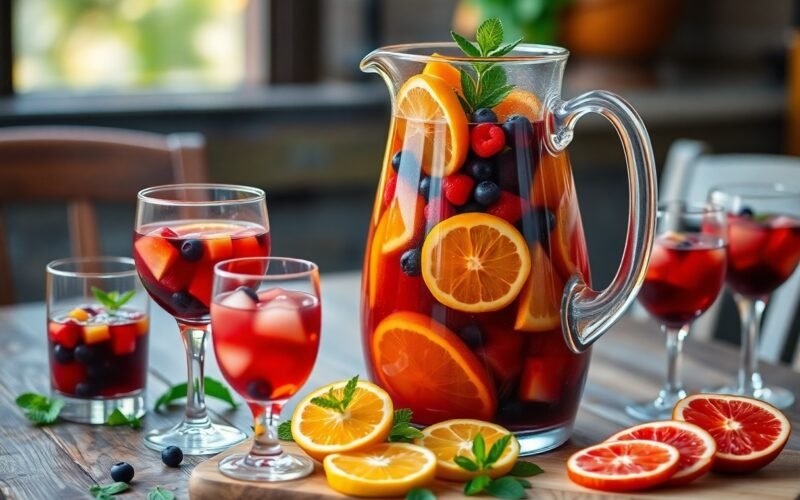Most people make simple yet significant mistakes when preparing sangria that can diminish its flavor and presentation. Whether you’re hosting a gathering or just enjoying a refreshing drink, understanding these common pitfalls will help you elevate your sangria game. From overloading on fruit to using the wrong type of wine, these errors can lead to an unbalanced beverage. In this post, you’ll discover how to avoid these missteps and craft the perfect sangria that delights your taste buds and impresses your guests.
Key Takeaways:
- Choosing low-quality or overly sweet wines can lead to an unbalanced sangria; opt for a good-quality dry wine for the best flavor.
- Overlooking the importance of fresh fruits and herbs can diminish the overall taste; always use seasonal and ripe produce to enhance the drink.
- Failing to let the sangria sit for a few hours or overnight can result in less developed flavors; allow sufficient time for infusing the ingredients.
The Pitfalls of Choosing Low-Quality Ingredients
Using low-quality ingredients can completely ruin your sangria experience. While it may be tempting to save money by opting for cheaper wines or canned fruits, these decisions often lead to a lackluster final product. Your sangria deserves to shine, so investing in quality ingredients will enhance not only the flavor but also the overall presentation. Aim for well-balanced wines, ripe fruits, and fragrant herbs to elevate your mix and create a refreshing beverage that you can proudly serve to your guests.
The Impact of Wine Selection
The choice of wine plays a pivotal role in the final flavor of your sangria. Using a cheap, overly sweet wine can result in a cloying drink that fails to impress; instead, go for a high-quality, dry wine that complements the added fruits and flavors. A Spanish red or white wine, like Tempranillo or Albariño, balances sweetness and acidity, creating a delightful harmony that enhances your sangria.
Importance of Fresh Fruits and Herbs
Fresh fruits and herbs are vital for crafting a vibrant sangria that bursts with flavor. While it might seem easy to grab a bag of frozen mixed fruits or dried herbs, these options often lack the freshness and vibrancy necessary for a truly refreshing drink. Using seasonal, ripe fruits—not only enhances the taste but also contributes beautiful colors and aromas that make your sangria visually appealing.
When incorporating fresh fruits like oranges, lemons, and berries, their juice infuses the sangria with depth and complexity, adding different layers to each sip. Similarly, fresh herbs such as mint or basil introduce aromatic notes that elevate the drink. For the best results, choose fruits that are at their peak ripeness, as they will provide the richest flavors and natural sweetness. Combining these fresh elements ensures your sangria avoids any dull or flat taste, leaving you with a delicious drink that’s refreshing any time of year.
Miscalculating Flavor Balance: The Sweet vs. Sour Dilemma
Finding the right balance between sweetness and acidity is vital to crafting a delightful sangria. Too much sweetness overshadows the refreshing qualities of your base wine, while excessive acidity can create an unappealing tang. The key lies in knowing your ingredients—sweet fruit, rich liqueurs, and citrus can all impact the final flavor profile. Experiment until you find that perfect harmony. It’s a fine line, but Here’s How To Make Sangria That Actually Tastes Good.
The Role of Sweeteners
Selecting sweeteners for your sangria requires thoughtful consideration. Rather than reaching for refined sugar, explore natural options like agave syrup or honey, which enhance the drink’s flavor profile without overwhelming it. Additionally, incorporate sweet fruits—such as peaches and oranges—which not only add sweetness but also contribute to the overall aroma and finish of your sangria.
Experimenting with Citrus Accents
Citrus accents like oranges, lemons, and limes can elevate your sangria from ordinary to extraordinary. These fruits introduce brightness and acidity that cut through sweetness and add complexity. Consider using a mix of zested and sliced fruits for a more vibrant presentation and varied flavor. The zest, in particular, contains necessary oils that can bring out hidden flavors in your sangria.
Utilizing citrus in your sangria isn’t limited to just the basic slices. You might muddle limes to release their oils or add a splash of fresh lemon juice to increase tartness. If you’re feeling adventurous, infuse your sangria by allowing the citrus to steep overnight to develop a stronger flavor base. This method lends a refreshing tang that balances the sweetness and keeps your sangria vibrant and engaging. Embrace the versatility of citrus to unlock unique tastes and pairings.

Neglecting Chill Time: Why Temperature Matters
Chilling your sangria properly transforms it into a refreshing beverage that accentuates the fruity flavors and invigorates the taste buds. Serving sangria too warm can result in an overly sweet or heavy experience, diminishing its zest and appeal. Take your time to chill your drink adequately before serving; a good rule of thumb is to let it sit in the refrigerator for at least two hours. For a guide on achieving a perfect blend of flavors, check out The Best Red Sangria (Recipe and Tips).
Common Mistakes in Chilling Techniques
| Chilling Method | Impact |
| Direct Ice | Watered-down flavors |
| Short Chill Time | Unbalanced taste |
| Pre-chilling Ingredients | Better flavor integration |
The Science Behind Serving Temperature
The temperature of your sangria plays a significant role in the overall tasting experience. Cold liquids tend to mute the flavors and aromas, while serving sangria at the ideal temperature allows the ingredients to harmonize. Generally, a chilled sangria should be served between 40°F to 50°F, providing a perfect balance of coldness and aromatic intensity. Ensuring the right serving temperature enhances your ability to enjoy the vibrant tastes of the fruits and spices that make sangria extraordinary.
Optimal Preparing Techniques
| Method | Duration |
| Refrigeration | Min 2 hours |
| Freezing Fruit | Overnight |
| Ice Bath | 30 minutes |
Recommendations for Optimal Chilling Methods
For the ultimate chilling experience, consider using the refrigerator for at least two hours before serving, allowing the sangria to become thoroughly infused with flavors. As an alternative, an ice bath can speed up the cooling process—place your sangria vessel in a larger bowl filled with ice and water for approximately 30 minutes. Lastly, freezing fruits overnight not only adds chill but also keeps your drink visually appealing as the fruit enhances the infused flavors without diluting them.
Overcomplicating Garnishes: Keeping It Simple
Garnishing your sangria can be a delightful way to elevate the drink, but complexities can lead to confusion rather than enhancement. Simple, vibrant garnishes such as fresh citrus slices or a handful of seasonal berries not only complement the fruity essence of the beverage but also maintain an inviting visual appeal. Strike a balance; too many elaborate garnishes can overpower the natural flavors, turning your refreshing drink into a muddled concoction. Opt for a few quality ingredients that highlight and enhance your sangria instead of overwhelming it.
Essential Garnishes That Enhance, Not Overwhelm
Choosing the right garnishes is an art form that can dramatically influence the drinking experience. Citrus fruits like oranges, lemons, or limes are staples that add brightness, while herbs like mint or basil can introduce an earthy note without clashing with the drink’s main flavors. A few simple additions are all you need to create visual appeal and taste harmony in your sangria.
The Role of Presentation in Enjoyment
Presentation plays a significant role in how you perceive your sangria and, more importantly, how much you enjoy it. Having a well-presented drink creates anticipation and enhances the overall experience. The vibrant colors of fresh fruit against the deep red of the wine can be visually captivating, making it a feast for the eyes before the first sip. Glassware also matters; using a large wine glass allows the aroma to flourish, inviting you to dive in. A thoughtful presentation doesn’t just please the eye; it sets the tone for a memorable occasion.
Skipping the Prep: The Importance of Proper Mixing
A well-mixed sangria is imperative for achieving a harmonious balance of flavors. Neglecting this step can lead to an uneven taste, where the acidity of the wine overshadows the sweetness of the fruits. Always take the time to How To Make Sangria – You’re Doing It All Wrong by ensuring that your ingredients are fully integrated before serving.
Techniques for Effective Mixing
To achieve the best results, start by adding your fruits to the base ingredients first, allowing their juices to mingle with the wine. Use a large spoon to stir gently, ensuring that the sweetness of the fruit blends seamlessly without bruising it. A large carafe or pitcher works well for mixing, enabling you to combine the various components effectively while allowing room for the flavors to bloom.
Timing: When to Mix for Maximum Flavor
Timing can significantly affect the flavor of your sangria. Mixing too early may result in over-infusion, while waiting too long can lead to a lackluster taste. Ideally, prepare your sangria a few hours before you plan to serve it, allowing the flavors to develop and meld.
Allowing your sangria to sit for at least two hours, preferably overnight, enables the fruits to release their juices, enhancing the drink’s overall flavor. This steeping time allows the wine to absorb the aromatic qualities of the fruits, resulting in a more vibrant and tasty beverage. Aim for around six to eight hours for the best blend, but if time is short, a two-hour mix can still elevate your sangria significantly. Avoid serving immediately after mixing, as the flavors may not fully develop and balance out, leading to a less enjoyable experience.
Final Words
With this in mind, avoiding common sangria mistakes can elevate your drink-making skills and impress your guests. Pay attention to the balance of flavors by using quality wines, fresh fruits, and thoughtful mixers. Don’t rush the infusion process, and feel free to experiment with different ingredients to suit your taste. By applying these tips, you’ll create refreshing sangrias that perfectly complement any occasion, leaving a lasting impression and making your gatherings even more enjoyable.
Q: What are the most common mistakes people make when preparing sangria?
A: One prevalent mistake is not allowing sufficient time for the flavors to meld. Many people serve sangria immediately after mixing the ingredients, but it’s best to let it chill in the refrigerator for at least a few hours, or ideally overnight. This allows the fruit and other flavors to infuse properly. Another mistake is using low-quality wine; investing in a decent bottle can significantly enhance the overall taste of the sangria. Lastly, some tend to overdo the sweetness by adding excessive sugary ingredients, which can overpower the drink.
Q: How can I avoid using low-quality wine in my sangria?
A: To avoid low-quality wine, consider a few factors when selecting your bottle. Firstly, choose a wine that you would enjoy drinking on its own. Look for wines labeled as “young” or “fruity,” which are great for sangria, such as Spanish Tempranillo, Garnacha, or even a light white like Sauvignon Blanc. Reading reviews or asking for recommendations at a wine shop can also help you pick a good quality wine without overspending. Finally, set a budget range—while you don’t need to choose the most expensive option, a mid-range wine will often provide the best flavor without breaking the bank.
Q: What should I do if my sangria turns out too sweet?
A: If your sangria ends up too sweet, there are a few adjustments you can make to balance the flavors. First, try adding a splash of citrus juice, like lemon or lime, to introduce acidity that counters the sweetness. Alternatively, a dash of sparkling water or soda can dilute the drink and add a refreshing aspect without introducing more sugar. If all else fails, serving your sangria over ice can help cut the sweetness and make it more enjoyable. Additionally, consider reducing sugar in your recipe next time by using fruit that’s naturally more tart or limiting sweet mixers.




